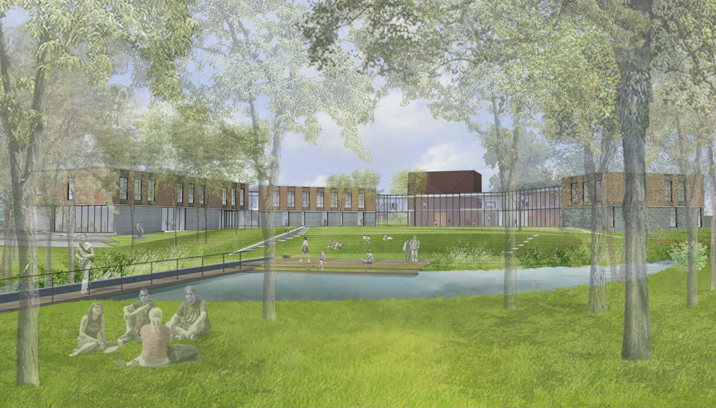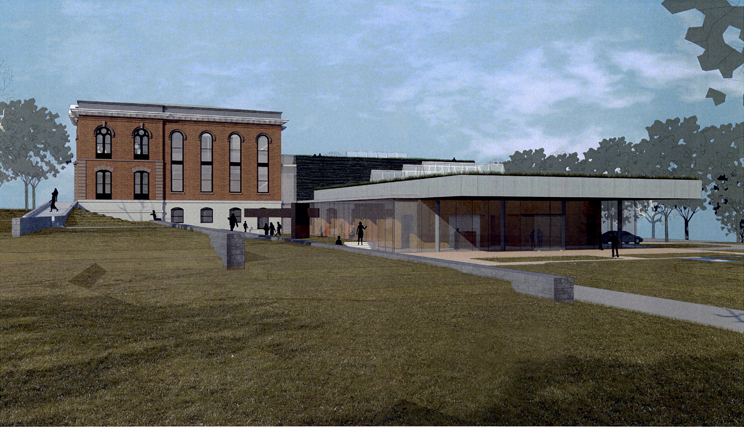

The arts programs at Hamilton are unlike those found at many other similarly prestigious academic institutions. On many campuses there is an implied exclusivity associated with the arts, an implication that these programs exist for the primary benefit of the "initiated" few who show real promise as art majors and future artists and that the participation of the larger student body is at best a "necessary evil," garnering to the arts departments impressive enrollment statistics that justify their existence. Such is not the case at Hamilton. The arts at Hamilton are inclusive in nature. They exist for and are truly open to all of the students, regardless of their major or future promise as professional artists.
Due to the overwhelming interest, the arts programs have outgrown their current facilities. Dispersed across campus, the facilities include List Hall, the basement of Dunham dormitory, Minor Theatre, Schambach Hall, and the Emerson Gallery, located in the Christian A. Johnson Hall. The geographical division of the facilities compromises the interdisciplinary exchange between departments that the college strives to achieve and hinders the interaction among students and faculty. The once fluid and dynamic environment of the original Kirkland studio buildings, encouraging student and student-faculty exchange, has been compromised to accommodate the departments' growing space needs. Storage spaces have been carved out of corridors and mechanical spaces while studios are obliged to double as workshops, creating less than ideal and sometimes hazardous work environments. The arts programs are in need of new facilities to accommodate the growing interest, recapture the architectual facilitation of interaction among students and between students and faculty, and provide opportunities for interdisciplinary exchange in a safe working environment.
A New Kind of Studio Art Space
The Hamilton College Theatre: a New Locus for Creative Activity on the Campus
A Proposal for a Studio for Transmedia Arts and Related Studies
The Teaching and Learning Museum at Hamilton, a statement by Ian Berry, Consulting Director of the Emerson Gallery
Teaching and Learning in the Hamilton College Museum, a statement by Professor John McEnroeand here are a few more good reasons to do this project now
In the spring of 2001, as part of the College's strategic planning process, an arts facilities subcommittee met often and produced a preliminary report (pdf file). Subsequently, the Strategic Plan issued in the spring of 2002 noted that:
Studio and theatre spaces are inadequate, and there are needs for better classrooms and office spaces in all departments. Support spaces for the arts ... also need to be upgraded. Additionally, the mission of the Emerson Gallery is seriously hampered by physical limitations, which also constrict the ability of the College to build an arts collection that complements the academic program. We need to address these space deficiencies in ways that highlight the value and the importance of the arts at Hamilton.
In 2003-2004, a task force of arts faculty members, with the assistance of Jane Lin and Duncan Hazard of the Polshek Partnership, reviewed recent studies and correspondence related to the state of the arts facilities at Hamilton, surveyed the present condition of the facilities, and discussed the programmatic and curricular directions that the arts departments are likely to pursue in the next few decades. In the spring of 2008, the College selected Machado and Silvetti Associates to undertake the design work for a new building for studio art and theatre and the renovation and expansion of Minor Theatre as a new gallery facility. By mid-2009 Machado and Silvetti had developed a set of schematic designs for the studio art and theatre facility and had developed a conceptual design for the gallery:
Our arts facilities should meet the spatial and functional needs of the arts departments and embody the spirit and nature of the programs. The arts facilities should exude a dynamic, creative, and inventive environment accessible to all students. The spaces should be fluid and flexible enough to accommodate the growing, changing needs of the arts departments and their students. They should also provide the arts with a strong unified identity and campus presence.
